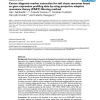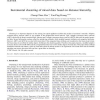27 search results - page 1 / 6 » Adaptive Resonance Theory Microchips |
IWANN
1999
Springer
13 years 9 months ago
1999
Springer
Recently, a real-time clustering microchip based on the ART1 algorithm has been reported. That chip was able to classify 100-bit input patterns into up to 18 categories. However, i...
IJCNN
2008
IEEE
13 years 11 months ago
2008
IEEE
Abstract— Adaptive Resonance Theory (ART) is an unsupervised neural network. Fuzzy ART (FART) is a variation of ART, allows both binary and continuous input patterns. However, Fu...
BMCBI
2006
13 years 4 months ago
2006
Background: Recent advances in genome technologies have provided an excellent opportunity to determine the complete biological characteristics of neoplastic tissues, resulting in ...
ICIP
2009
IEEE
14 years 5 months ago
2009
IEEE
A correct video segmentation, namely the detection of moving objects within a scene plays a very important role in many application in safety, surveillance, trafic monitoring and ...
ESWA
2008
13 years 4 months ago
2008
Clustering is an important function in data mining. Its typical application includes the analysis of consumer's materials. Adaptive resonance theory network (ART) is very pop...


